Comparison of Traditional vs Systematic OSH Management
VerifiedAdded on 2023/01/16
|11
|3451
|1
AI Summary
This report discusses the comparison between traditional and systematic Occupational Safety and Health (OSH) management. It explores the key elements of an ideal OSH management system practiced in the HKSAR construction industry and equipment & maintenance. The report also analyzes the supervisory organization and legal framework of OSH in HKSAR.
Contribute Materials
Your contribution can guide someone’s learning journey. Share your
documents today.
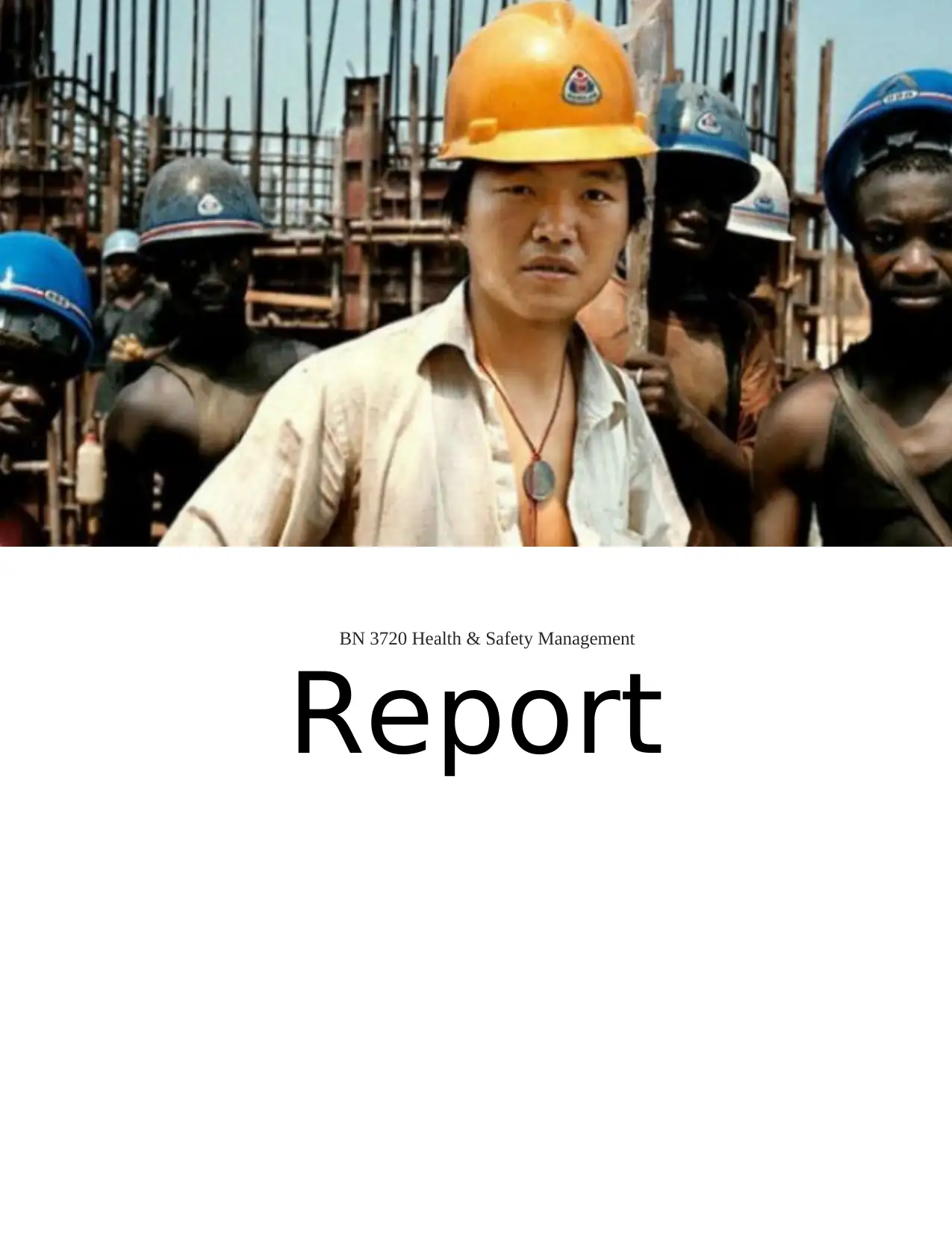
BN 3720 Health & Safety Management
Report
Report
Secure Best Marks with AI Grader
Need help grading? Try our AI Grader for instant feedback on your assignments.
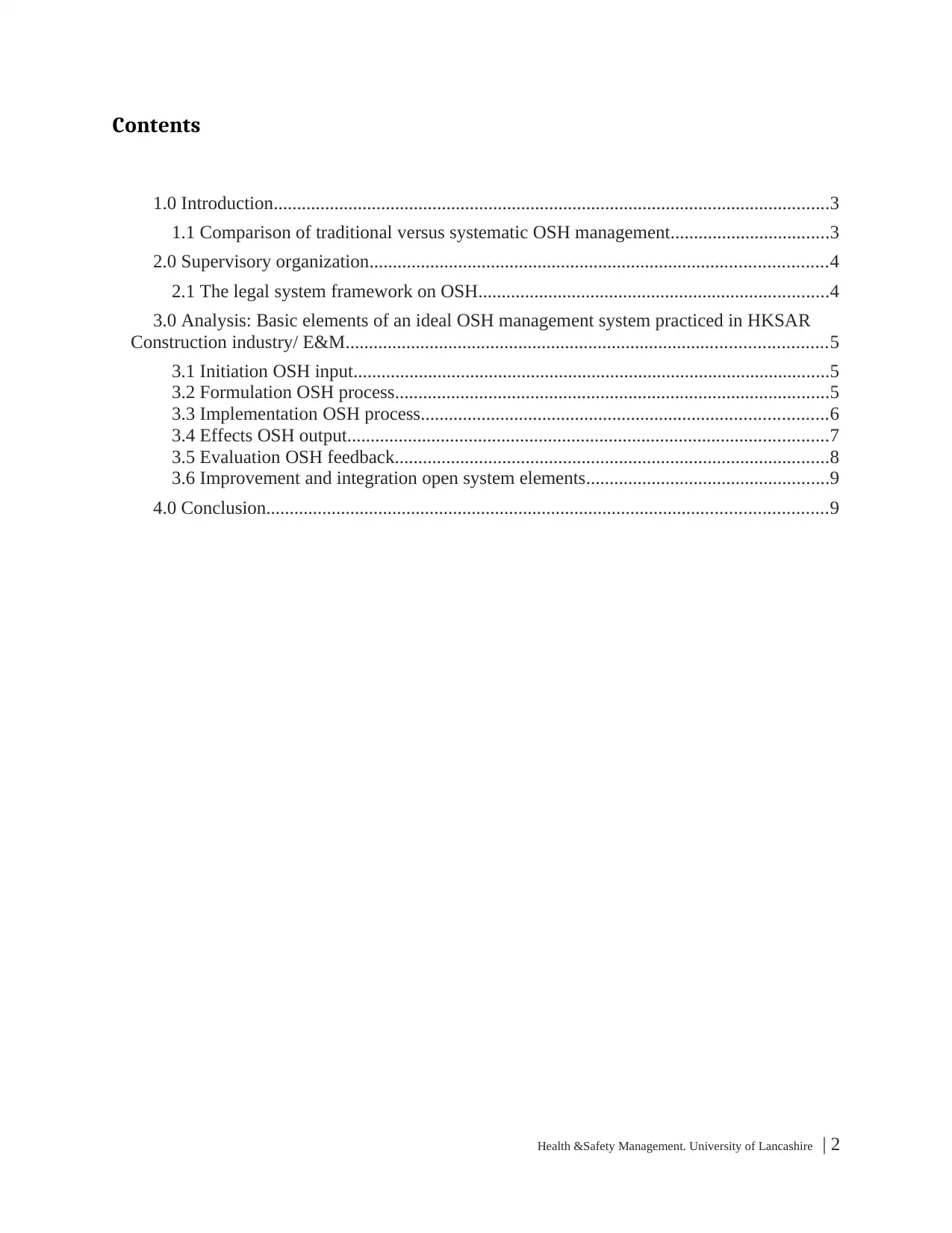
Contents
1.0 Introduction.......................................................................................................................3
1.1 Comparison of traditional versus systematic OSH management..................................3
2.0 Supervisory organization..................................................................................................4
2.1 The legal system framework on OSH...........................................................................4
3.0 Analysis: Basic elements of an ideal OSH management system practiced in HKSAR
Construction industry/ E&M.......................................................................................................5
3.1 Initiation OSH input......................................................................................................5
3.2 Formulation OSH process.............................................................................................5
3.3 Implementation OSH process.......................................................................................6
3.4 Effects OSH output.......................................................................................................7
3.5 Evaluation OSH feedback.............................................................................................8
3.6 Improvement and integration open system elements....................................................9
4.0 Conclusion........................................................................................................................9
Health &Safety Management. University of Lancashire | 2
1.0 Introduction.......................................................................................................................3
1.1 Comparison of traditional versus systematic OSH management..................................3
2.0 Supervisory organization..................................................................................................4
2.1 The legal system framework on OSH...........................................................................4
3.0 Analysis: Basic elements of an ideal OSH management system practiced in HKSAR
Construction industry/ E&M.......................................................................................................5
3.1 Initiation OSH input......................................................................................................5
3.2 Formulation OSH process.............................................................................................5
3.3 Implementation OSH process.......................................................................................6
3.4 Effects OSH output.......................................................................................................7
3.5 Evaluation OSH feedback.............................................................................................8
3.6 Improvement and integration open system elements....................................................9
4.0 Conclusion........................................................................................................................9
Health &Safety Management. University of Lancashire | 2
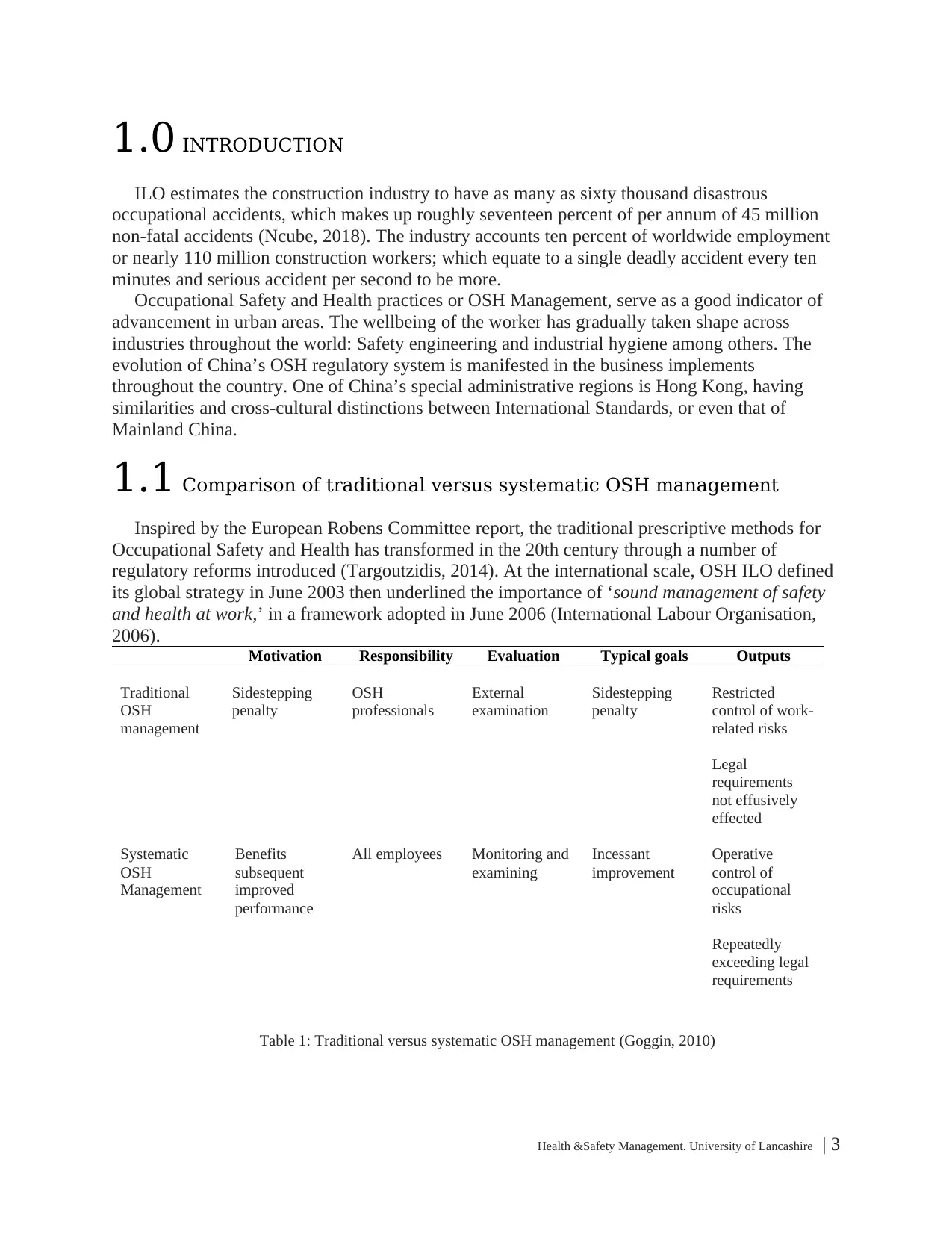
1.0 INTRODUCTION
ILO estimates the construction industry to have as many as sixty thousand disastrous
occupational accidents, which makes up roughly seventeen percent of per annum of 45 million
non-fatal accidents (Ncube, 2018). The industry accounts ten percent of worldwide employment
or nearly 110 million construction workers; which equate to a single deadly accident every ten
minutes and serious accident per second to be more.
Occupational Safety and Health practices or OSH Management, serve as a good indicator of
advancement in urban areas. The wellbeing of the worker has gradually taken shape across
industries throughout the world: Safety engineering and industrial hygiene among others. The
evolution of China’s OSH regulatory system is manifested in the business implements
throughout the country. One of China’s special administrative regions is Hong Kong, having
similarities and cross-cultural distinctions between International Standards, or even that of
Mainland China.
1.1 Comparison of traditional versus systematic OSH management
Inspired by the European Robens Committee report, the traditional prescriptive methods for
Occupational Safety and Health has transformed in the 20th century through a number of
regulatory reforms introduced (Targoutzidis, 2014). At the international scale, OSH ILO defined
its global strategy in June 2003 then underlined the importance of ‘sound management of safety
and health at work,’ in a framework adopted in June 2006 (International Labour Organisation,
2006).
Motivation Responsibility Evaluation Typical goals Outputs
Traditional
OSH
management
Sidestepping
penalty
OSH
professionals
External
examination
Sidestepping
penalty
Restricted
control of work-
related risks
Legal
requirements
not effusively
effected
Systematic
OSH
Management
Benefits
subsequent
improved
performance
All employees Monitoring and
examining
Incessant
improvement
Operative
control of
occupational
risks
Repeatedly
exceeding legal
requirements
Table 1: Traditional versus systematic OSH management (Goggin, 2010)
Health &Safety Management. University of Lancashire | 3
ILO estimates the construction industry to have as many as sixty thousand disastrous
occupational accidents, which makes up roughly seventeen percent of per annum of 45 million
non-fatal accidents (Ncube, 2018). The industry accounts ten percent of worldwide employment
or nearly 110 million construction workers; which equate to a single deadly accident every ten
minutes and serious accident per second to be more.
Occupational Safety and Health practices or OSH Management, serve as a good indicator of
advancement in urban areas. The wellbeing of the worker has gradually taken shape across
industries throughout the world: Safety engineering and industrial hygiene among others. The
evolution of China’s OSH regulatory system is manifested in the business implements
throughout the country. One of China’s special administrative regions is Hong Kong, having
similarities and cross-cultural distinctions between International Standards, or even that of
Mainland China.
1.1 Comparison of traditional versus systematic OSH management
Inspired by the European Robens Committee report, the traditional prescriptive methods for
Occupational Safety and Health has transformed in the 20th century through a number of
regulatory reforms introduced (Targoutzidis, 2014). At the international scale, OSH ILO defined
its global strategy in June 2003 then underlined the importance of ‘sound management of safety
and health at work,’ in a framework adopted in June 2006 (International Labour Organisation,
2006).
Motivation Responsibility Evaluation Typical goals Outputs
Traditional
OSH
management
Sidestepping
penalty
OSH
professionals
External
examination
Sidestepping
penalty
Restricted
control of work-
related risks
Legal
requirements
not effusively
effected
Systematic
OSH
Management
Benefits
subsequent
improved
performance
All employees Monitoring and
examining
Incessant
improvement
Operative
control of
occupational
risks
Repeatedly
exceeding legal
requirements
Table 1: Traditional versus systematic OSH management (Goggin, 2010)
Health &Safety Management. University of Lancashire | 3
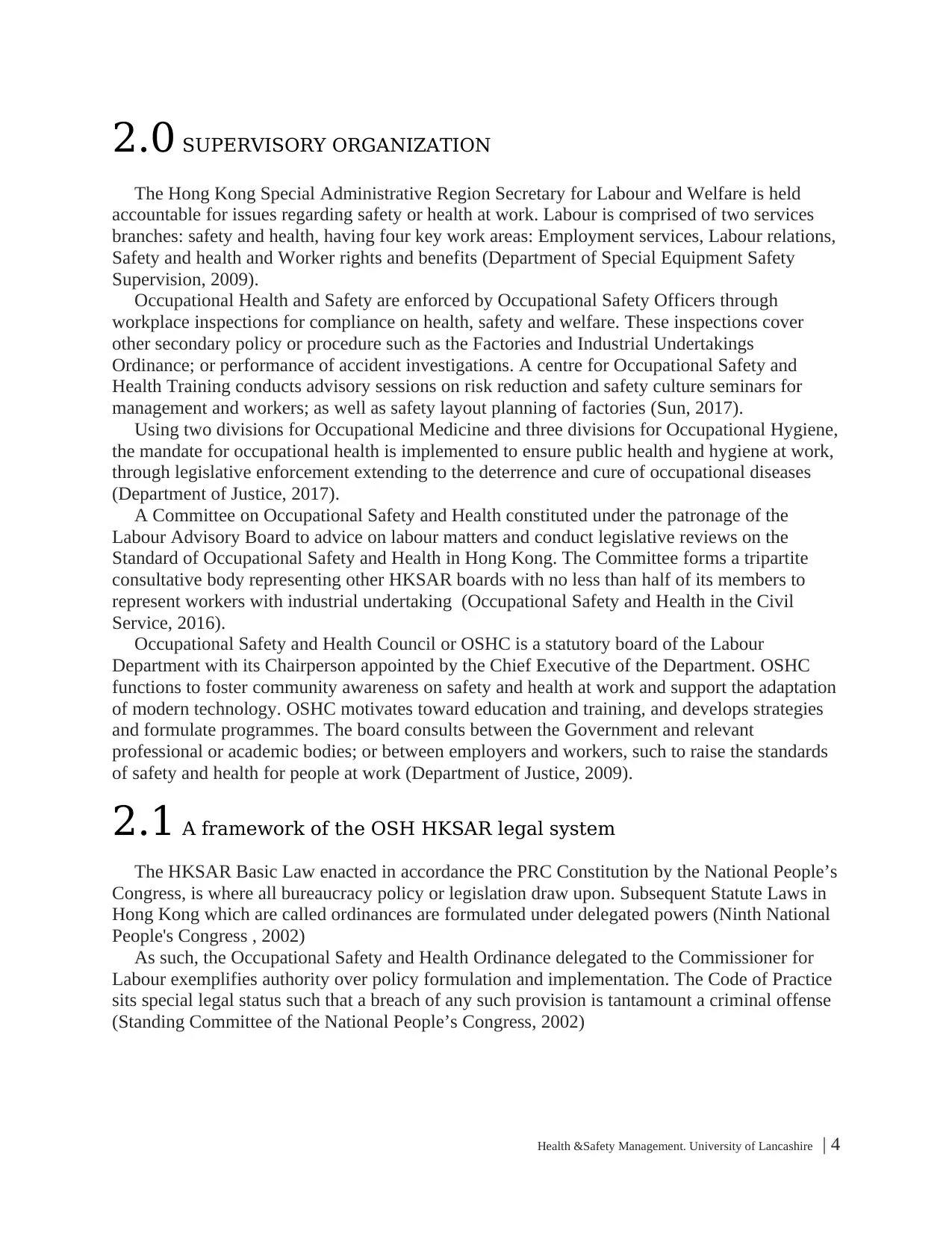
2.0 SUPERVISORY ORGANIZATION
The Hong Kong Special Administrative Region Secretary for Labour and Welfare is held
accountable for issues regarding safety or health at work. Labour is comprised of two services
branches: safety and health, having four key work areas: Employment services, Labour relations,
Safety and health and Worker rights and benefits (Department of Special Equipment Safety
Supervision, 2009).
Occupational Health and Safety are enforced by Occupational Safety Officers through
workplace inspections for compliance on health, safety and welfare. These inspections cover
other secondary policy or procedure such as the Factories and Industrial Undertakings
Ordinance; or performance of accident investigations. A centre for Occupational Safety and
Health Training conducts advisory sessions on risk reduction and safety culture seminars for
management and workers; as well as safety layout planning of factories (Sun, 2017).
Using two divisions for Occupational Medicine and three divisions for Occupational Hygiene,
the mandate for occupational health is implemented to ensure public health and hygiene at work,
through legislative enforcement extending to the deterrence and cure of occupational diseases
(Department of Justice, 2017).
A Committee on Occupational Safety and Health constituted under the patronage of the
Labour Advisory Board to advice on labour matters and conduct legislative reviews on the
Standard of Occupational Safety and Health in Hong Kong. The Committee forms a tripartite
consultative body representing other HKSAR boards with no less than half of its members to
represent workers with industrial undertaking (Occupational Safety and Health in the Civil
Service, 2016).
Occupational Safety and Health Council or OSHC is a statutory board of the Labour
Department with its Chairperson appointed by the Chief Executive of the Department. OSHC
functions to foster community awareness on safety and health at work and support the adaptation
of modern technology. OSHC motivates toward education and training, and develops strategies
and formulate programmes. The board consults between the Government and relevant
professional or academic bodies; or between employers and workers, such to raise the standards
of safety and health for people at work (Department of Justice, 2009).
2.1 A framework of the OSH HKSAR legal system
The HKSAR Basic Law enacted in accordance the PRC Constitution by the National People’s
Congress, is where all bureaucracy policy or legislation draw upon. Subsequent Statute Laws in
Hong Kong which are called ordinances are formulated under delegated powers (Ninth National
People's Congress , 2002)
As such, the Occupational Safety and Health Ordinance delegated to the Commissioner for
Labour exemplifies authority over policy formulation and implementation. The Code of Practice
sits special legal status such that a breach of any such provision is tantamount a criminal offense
(Standing Committee of the National People’s Congress, 2002)
Health &Safety Management. University of Lancashire | 4
The Hong Kong Special Administrative Region Secretary for Labour and Welfare is held
accountable for issues regarding safety or health at work. Labour is comprised of two services
branches: safety and health, having four key work areas: Employment services, Labour relations,
Safety and health and Worker rights and benefits (Department of Special Equipment Safety
Supervision, 2009).
Occupational Health and Safety are enforced by Occupational Safety Officers through
workplace inspections for compliance on health, safety and welfare. These inspections cover
other secondary policy or procedure such as the Factories and Industrial Undertakings
Ordinance; or performance of accident investigations. A centre for Occupational Safety and
Health Training conducts advisory sessions on risk reduction and safety culture seminars for
management and workers; as well as safety layout planning of factories (Sun, 2017).
Using two divisions for Occupational Medicine and three divisions for Occupational Hygiene,
the mandate for occupational health is implemented to ensure public health and hygiene at work,
through legislative enforcement extending to the deterrence and cure of occupational diseases
(Department of Justice, 2017).
A Committee on Occupational Safety and Health constituted under the patronage of the
Labour Advisory Board to advice on labour matters and conduct legislative reviews on the
Standard of Occupational Safety and Health in Hong Kong. The Committee forms a tripartite
consultative body representing other HKSAR boards with no less than half of its members to
represent workers with industrial undertaking (Occupational Safety and Health in the Civil
Service, 2016).
Occupational Safety and Health Council or OSHC is a statutory board of the Labour
Department with its Chairperson appointed by the Chief Executive of the Department. OSHC
functions to foster community awareness on safety and health at work and support the adaptation
of modern technology. OSHC motivates toward education and training, and develops strategies
and formulate programmes. The board consults between the Government and relevant
professional or academic bodies; or between employers and workers, such to raise the standards
of safety and health for people at work (Department of Justice, 2009).
2.1 A framework of the OSH HKSAR legal system
The HKSAR Basic Law enacted in accordance the PRC Constitution by the National People’s
Congress, is where all bureaucracy policy or legislation draw upon. Subsequent Statute Laws in
Hong Kong which are called ordinances are formulated under delegated powers (Ninth National
People's Congress , 2002)
As such, the Occupational Safety and Health Ordinance delegated to the Commissioner for
Labour exemplifies authority over policy formulation and implementation. The Code of Practice
sits special legal status such that a breach of any such provision is tantamount a criminal offense
(Standing Committee of the National People’s Congress, 2002)
Health &Safety Management. University of Lancashire | 4
Secure Best Marks with AI Grader
Need help grading? Try our AI Grader for instant feedback on your assignments.
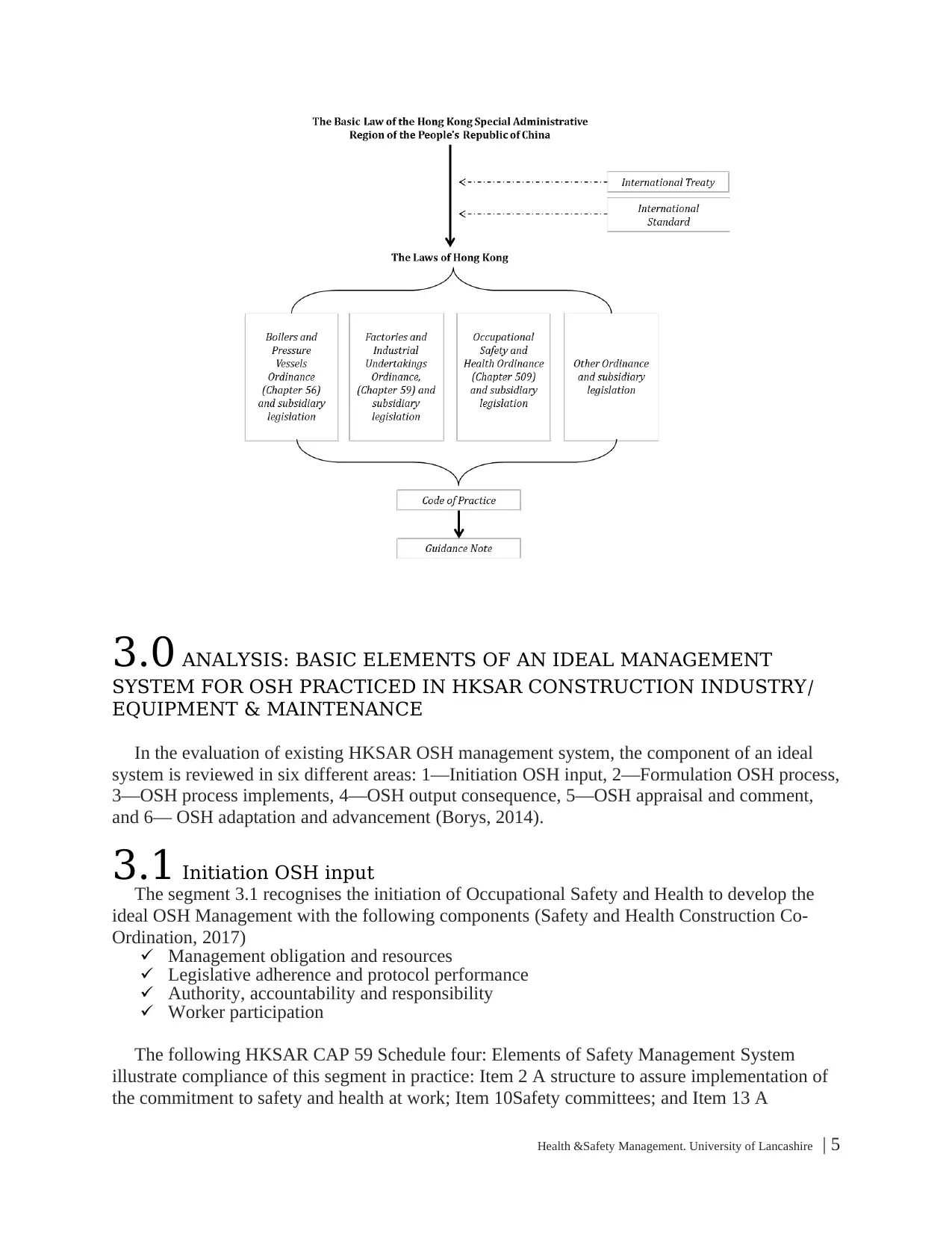
3.0 ANALYSIS: BASIC ELEMENTS OF AN IDEAL MANAGEMENT
SYSTEM FOR OSH PRACTICED IN HKSAR CONSTRUCTION INDUSTRY/
EQUIPMENT & MAINTENANCE
In the evaluation of existing HKSAR OSH management system, the component of an ideal
system is reviewed in six different areas: 1—Initiation OSH input, 2—Formulation OSH process,
3—OSH process implements, 4—OSH output consequence, 5—OSH appraisal and comment,
and 6— OSH adaptation and advancement (Borys, 2014).
3.1 Initiation OSH input
The segment 3.1 recognises the initiation of Occupational Safety and Health to develop the
ideal OSH Management with the following components (Safety and Health Construction Co-
Ordination, 2017)
Management obligation and resources
Legislative adherence and protocol performance
Authority, accountability and responsibility
Worker participation
The following HKSAR CAP 59 Schedule four: Elements of Safety Management System
illustrate compliance of this segment in practice: Item 2 A structure to assure implementation of
the commitment to safety and health at work; Item 10Safety committees; and Item 13 A
Health &Safety Management. University of Lancashire | 5
SYSTEM FOR OSH PRACTICED IN HKSAR CONSTRUCTION INDUSTRY/
EQUIPMENT & MAINTENANCE
In the evaluation of existing HKSAR OSH management system, the component of an ideal
system is reviewed in six different areas: 1—Initiation OSH input, 2—Formulation OSH process,
3—OSH process implements, 4—OSH output consequence, 5—OSH appraisal and comment,
and 6— OSH adaptation and advancement (Borys, 2014).
3.1 Initiation OSH input
The segment 3.1 recognises the initiation of Occupational Safety and Health to develop the
ideal OSH Management with the following components (Safety and Health Construction Co-
Ordination, 2017)
Management obligation and resources
Legislative adherence and protocol performance
Authority, accountability and responsibility
Worker participation
The following HKSAR CAP 59 Schedule four: Elements of Safety Management System
illustrate compliance of this segment in practice: Item 2 A structure to assure implementation of
the commitment to safety and health at work; Item 10Safety committees; and Item 13 A
Health &Safety Management. University of Lancashire | 5
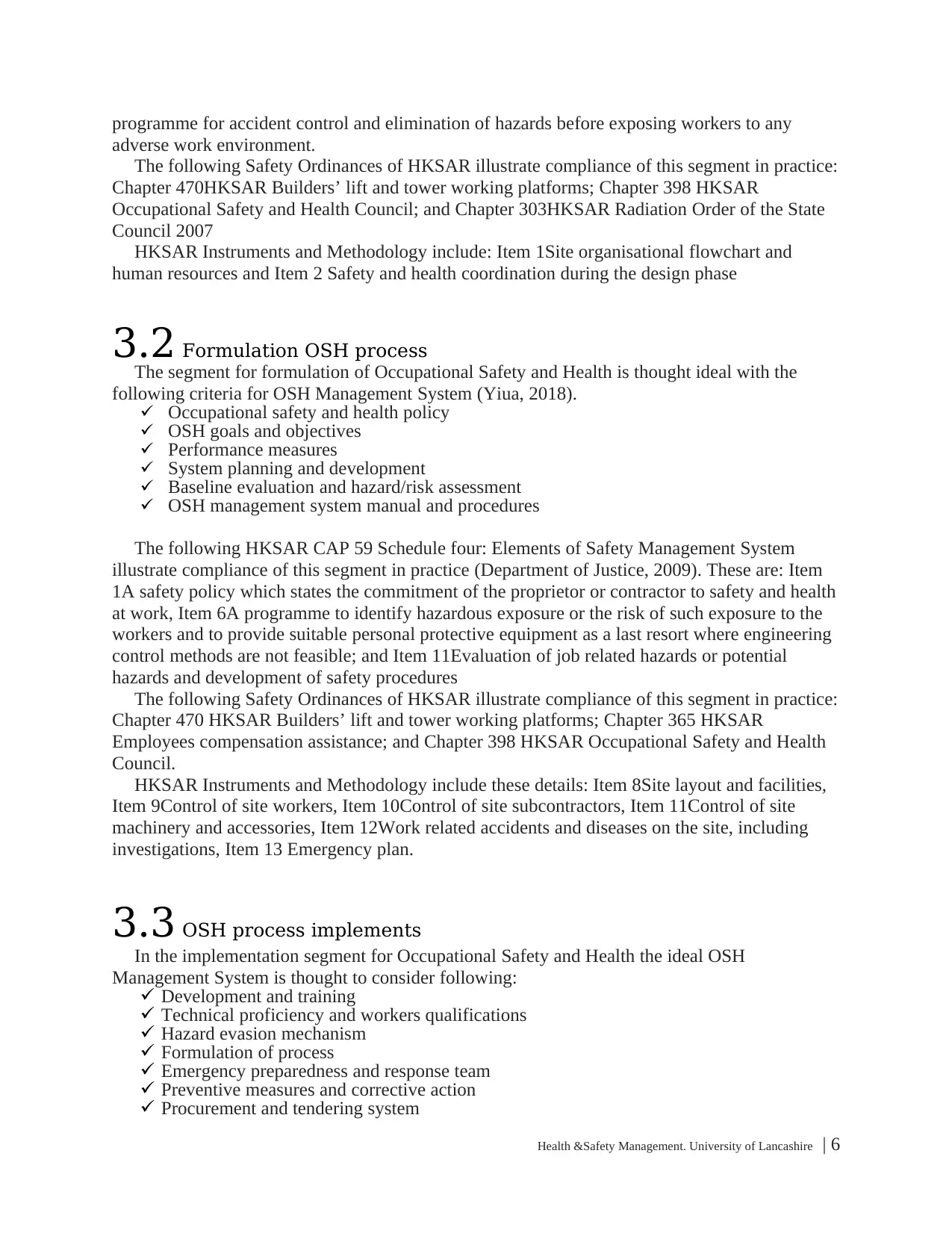
programme for accident control and elimination of hazards before exposing workers to any
adverse work environment.
The following Safety Ordinances of HKSAR illustrate compliance of this segment in practice:
Chapter 470HKSAR Builders’ lift and tower working platforms; Chapter 398 HKSAR
Occupational Safety and Health Council; and Chapter 303HKSAR Radiation Order of the State
Council 2007
HKSAR Instruments and Methodology include: Item 1Site organisational flowchart and
human resources and Item 2 Safety and health coordination during the design phase
3.2 Formulation OSH process
The segment for formulation of Occupational Safety and Health is thought ideal with the
following criteria for OSH Management System (Yiua, 2018).
Occupational safety and health policy
OSH goals and objectives
Performance measures
System planning and development
Baseline evaluation and hazard/risk assessment
OSH management system manual and procedures
The following HKSAR CAP 59 Schedule four: Elements of Safety Management System
illustrate compliance of this segment in practice (Department of Justice, 2009). These are: Item
1A safety policy which states the commitment of the proprietor or contractor to safety and health
at work, Item 6A programme to identify hazardous exposure or the risk of such exposure to the
workers and to provide suitable personal protective equipment as a last resort where engineering
control methods are not feasible; and Item 11Evaluation of job related hazards or potential
hazards and development of safety procedures
The following Safety Ordinances of HKSAR illustrate compliance of this segment in practice:
Chapter 470 HKSAR Builders’ lift and tower working platforms; Chapter 365 HKSAR
Employees compensation assistance; and Chapter 398 HKSAR Occupational Safety and Health
Council.
HKSAR Instruments and Methodology include these details: Item 8Site layout and facilities,
Item 9Control of site workers, Item 10Control of site subcontractors, Item 11Control of site
machinery and accessories, Item 12Work related accidents and diseases on the site, including
investigations, Item 13 Emergency plan.
3.3 OSH process implements
In the implementation segment for Occupational Safety and Health the ideal OSH
Management System is thought to consider following:
Development and training
Technical proficiency and workers qualifications
Hazard evasion mechanism
Formulation of process
Emergency preparedness and response team
Preventive measures and corrective action
Procurement and tendering system
Health &Safety Management. University of Lancashire | 6
adverse work environment.
The following Safety Ordinances of HKSAR illustrate compliance of this segment in practice:
Chapter 470HKSAR Builders’ lift and tower working platforms; Chapter 398 HKSAR
Occupational Safety and Health Council; and Chapter 303HKSAR Radiation Order of the State
Council 2007
HKSAR Instruments and Methodology include: Item 1Site organisational flowchart and
human resources and Item 2 Safety and health coordination during the design phase
3.2 Formulation OSH process
The segment for formulation of Occupational Safety and Health is thought ideal with the
following criteria for OSH Management System (Yiua, 2018).
Occupational safety and health policy
OSH goals and objectives
Performance measures
System planning and development
Baseline evaluation and hazard/risk assessment
OSH management system manual and procedures
The following HKSAR CAP 59 Schedule four: Elements of Safety Management System
illustrate compliance of this segment in practice (Department of Justice, 2009). These are: Item
1A safety policy which states the commitment of the proprietor or contractor to safety and health
at work, Item 6A programme to identify hazardous exposure or the risk of such exposure to the
workers and to provide suitable personal protective equipment as a last resort where engineering
control methods are not feasible; and Item 11Evaluation of job related hazards or potential
hazards and development of safety procedures
The following Safety Ordinances of HKSAR illustrate compliance of this segment in practice:
Chapter 470 HKSAR Builders’ lift and tower working platforms; Chapter 365 HKSAR
Employees compensation assistance; and Chapter 398 HKSAR Occupational Safety and Health
Council.
HKSAR Instruments and Methodology include these details: Item 8Site layout and facilities,
Item 9Control of site workers, Item 10Control of site subcontractors, Item 11Control of site
machinery and accessories, Item 12Work related accidents and diseases on the site, including
investigations, Item 13 Emergency plan.
3.3 OSH process implements
In the implementation segment for Occupational Safety and Health the ideal OSH
Management System is thought to consider following:
Development and training
Technical proficiency and workers qualifications
Hazard evasion mechanism
Formulation of process
Emergency preparedness and response team
Preventive measures and corrective action
Procurement and tendering system
Health &Safety Management. University of Lancashire | 6
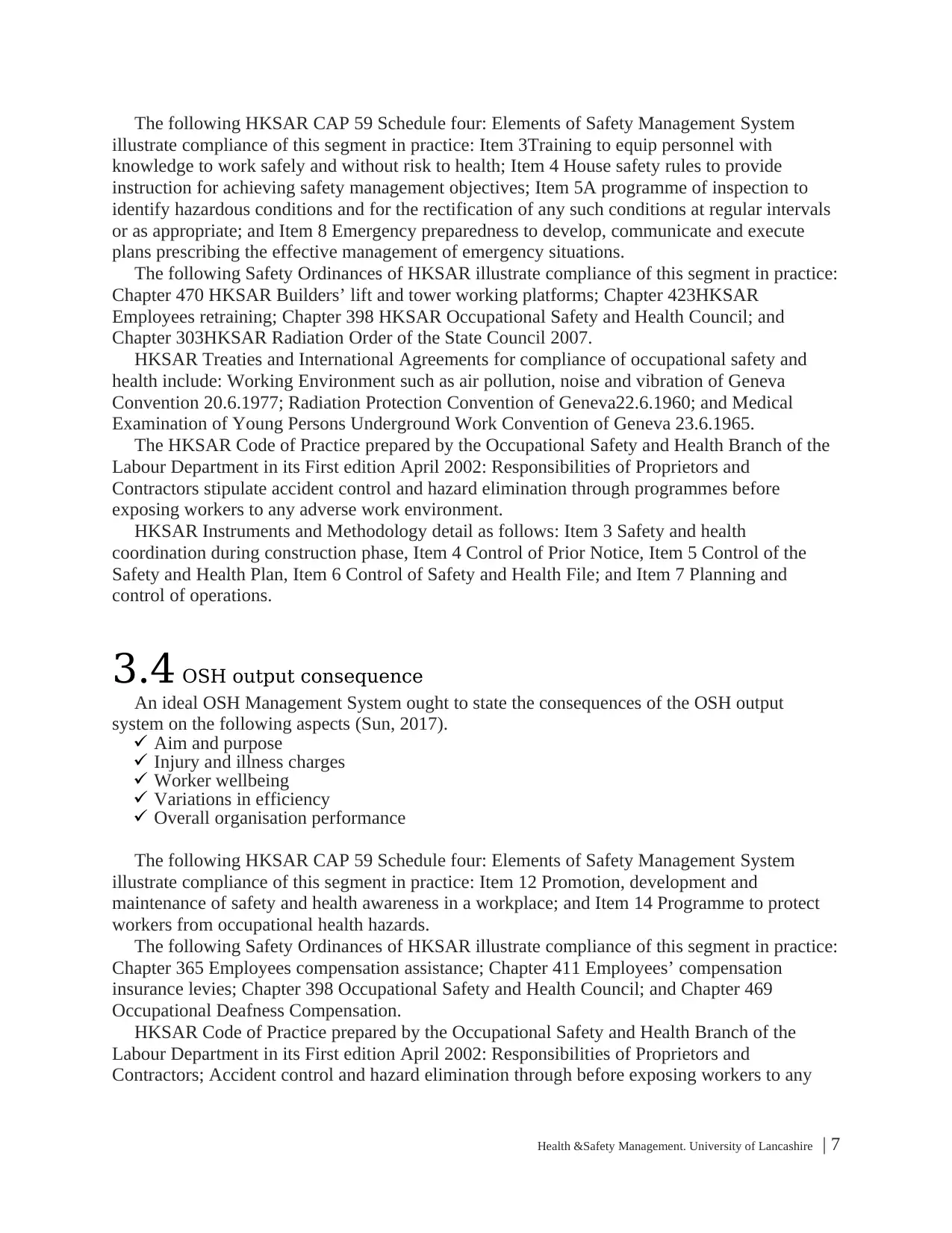
The following HKSAR CAP 59 Schedule four: Elements of Safety Management System
illustrate compliance of this segment in practice: Item 3Training to equip personnel with
knowledge to work safely and without risk to health; Item 4 House safety rules to provide
instruction for achieving safety management objectives; Item 5A programme of inspection to
identify hazardous conditions and for the rectification of any such conditions at regular intervals
or as appropriate; and Item 8 Emergency preparedness to develop, communicate and execute
plans prescribing the effective management of emergency situations.
The following Safety Ordinances of HKSAR illustrate compliance of this segment in practice:
Chapter 470 HKSAR Builders’ lift and tower working platforms; Chapter 423HKSAR
Employees retraining; Chapter 398 HKSAR Occupational Safety and Health Council; and
Chapter 303HKSAR Radiation Order of the State Council 2007.
HKSAR Treaties and International Agreements for compliance of occupational safety and
health include: Working Environment such as air pollution, noise and vibration of Geneva
Convention 20.6.1977; Radiation Protection Convention of Geneva22.6.1960; and Medical
Examination of Young Persons Underground Work Convention of Geneva 23.6.1965.
The HKSAR Code of Practice prepared by the Occupational Safety and Health Branch of the
Labour Department in its First edition April 2002: Responsibilities of Proprietors and
Contractors stipulate accident control and hazard elimination through programmes before
exposing workers to any adverse work environment.
HKSAR Instruments and Methodology detail as follows: Item 3 Safety and health
coordination during construction phase, Item 4 Control of Prior Notice, Item 5 Control of the
Safety and Health Plan, Item 6 Control of Safety and Health File; and Item 7 Planning and
control of operations.
3.4 OSH output consequence
An ideal OSH Management System ought to state the consequences of the OSH output
system on the following aspects (Sun, 2017).
Aim and purpose
Injury and illness charges
Worker wellbeing
Variations in efficiency
Overall organisation performance
The following HKSAR CAP 59 Schedule four: Elements of Safety Management System
illustrate compliance of this segment in practice: Item 12 Promotion, development and
maintenance of safety and health awareness in a workplace; and Item 14 Programme to protect
workers from occupational health hazards.
The following Safety Ordinances of HKSAR illustrate compliance of this segment in practice:
Chapter 365 Employees compensation assistance; Chapter 411 Employees’ compensation
insurance levies; Chapter 398 Occupational Safety and Health Council; and Chapter 469
Occupational Deafness Compensation.
HKSAR Code of Practice prepared by the Occupational Safety and Health Branch of the
Labour Department in its First edition April 2002: Responsibilities of Proprietors and
Contractors; Accident control and hazard elimination through before exposing workers to any
Health &Safety Management. University of Lancashire | 7
illustrate compliance of this segment in practice: Item 3Training to equip personnel with
knowledge to work safely and without risk to health; Item 4 House safety rules to provide
instruction for achieving safety management objectives; Item 5A programme of inspection to
identify hazardous conditions and for the rectification of any such conditions at regular intervals
or as appropriate; and Item 8 Emergency preparedness to develop, communicate and execute
plans prescribing the effective management of emergency situations.
The following Safety Ordinances of HKSAR illustrate compliance of this segment in practice:
Chapter 470 HKSAR Builders’ lift and tower working platforms; Chapter 423HKSAR
Employees retraining; Chapter 398 HKSAR Occupational Safety and Health Council; and
Chapter 303HKSAR Radiation Order of the State Council 2007.
HKSAR Treaties and International Agreements for compliance of occupational safety and
health include: Working Environment such as air pollution, noise and vibration of Geneva
Convention 20.6.1977; Radiation Protection Convention of Geneva22.6.1960; and Medical
Examination of Young Persons Underground Work Convention of Geneva 23.6.1965.
The HKSAR Code of Practice prepared by the Occupational Safety and Health Branch of the
Labour Department in its First edition April 2002: Responsibilities of Proprietors and
Contractors stipulate accident control and hazard elimination through programmes before
exposing workers to any adverse work environment.
HKSAR Instruments and Methodology detail as follows: Item 3 Safety and health
coordination during construction phase, Item 4 Control of Prior Notice, Item 5 Control of the
Safety and Health Plan, Item 6 Control of Safety and Health File; and Item 7 Planning and
control of operations.
3.4 OSH output consequence
An ideal OSH Management System ought to state the consequences of the OSH output
system on the following aspects (Sun, 2017).
Aim and purpose
Injury and illness charges
Worker wellbeing
Variations in efficiency
Overall organisation performance
The following HKSAR CAP 59 Schedule four: Elements of Safety Management System
illustrate compliance of this segment in practice: Item 12 Promotion, development and
maintenance of safety and health awareness in a workplace; and Item 14 Programme to protect
workers from occupational health hazards.
The following Safety Ordinances of HKSAR illustrate compliance of this segment in practice:
Chapter 365 Employees compensation assistance; Chapter 411 Employees’ compensation
insurance levies; Chapter 398 Occupational Safety and Health Council; and Chapter 469
Occupational Deafness Compensation.
HKSAR Code of Practice prepared by the Occupational Safety and Health Branch of the
Labour Department in its First edition April 2002: Responsibilities of Proprietors and
Contractors; Accident control and hazard elimination through before exposing workers to any
Health &Safety Management. University of Lancashire | 7
Paraphrase This Document
Need a fresh take? Get an instant paraphrase of this document with our AI Paraphraser
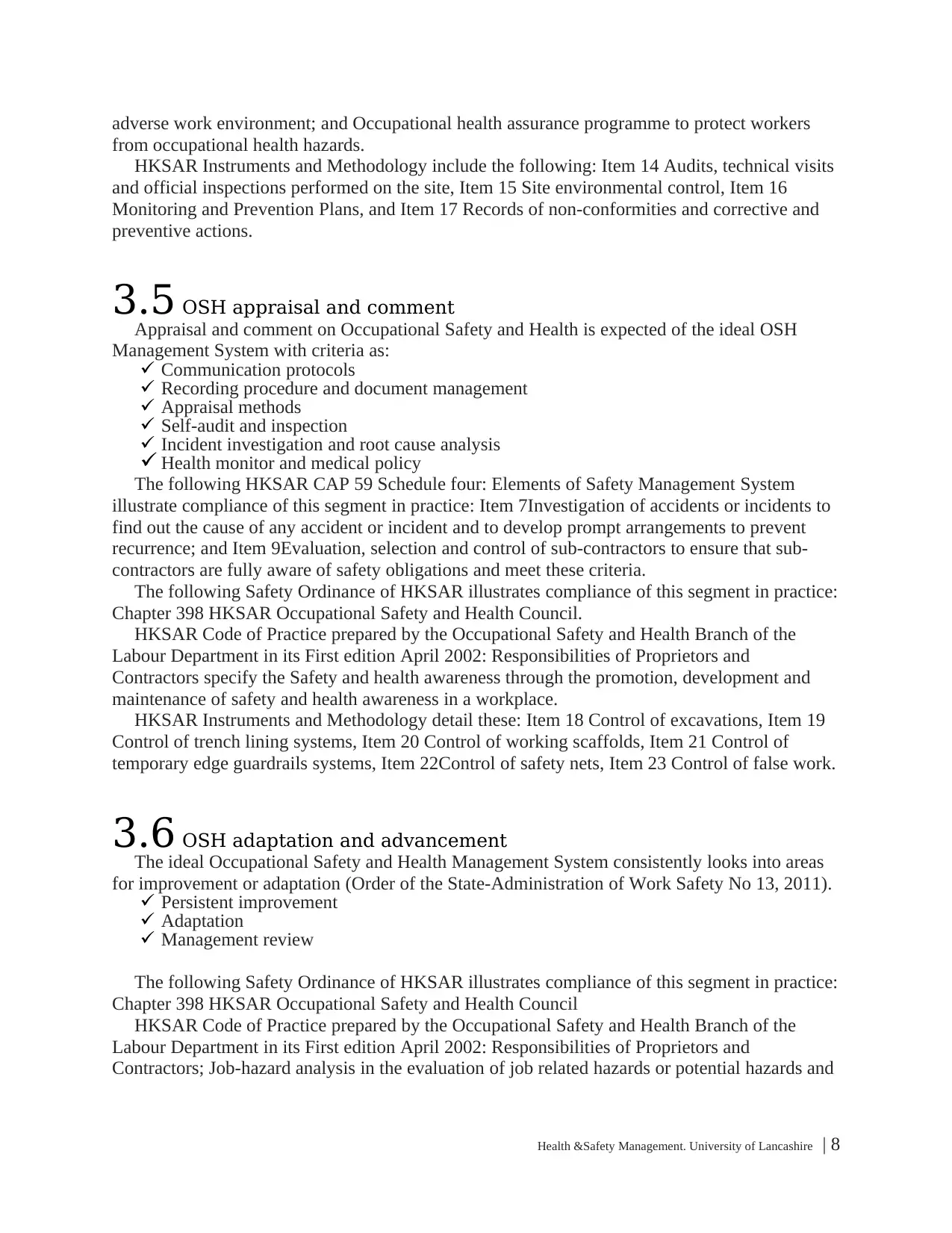
adverse work environment; and Occupational health assurance programme to protect workers
from occupational health hazards.
HKSAR Instruments and Methodology include the following: Item 14 Audits, technical visits
and official inspections performed on the site, Item 15 Site environmental control, Item 16
Monitoring and Prevention Plans, and Item 17 Records of non-conformities and corrective and
preventive actions.
3.5 OSH appraisal and comment
Appraisal and comment on Occupational Safety and Health is expected of the ideal OSH
Management System with criteria as:
Communication protocols
Recording procedure and document management
Appraisal methods
Self-audit and inspection
Incident investigation and root cause analysis
Health monitor and medical policy
The following HKSAR CAP 59 Schedule four: Elements of Safety Management System
illustrate compliance of this segment in practice: Item 7Investigation of accidents or incidents to
find out the cause of any accident or incident and to develop prompt arrangements to prevent
recurrence; and Item 9Evaluation, selection and control of sub-contractors to ensure that sub-
contractors are fully aware of safety obligations and meet these criteria.
The following Safety Ordinance of HKSAR illustrates compliance of this segment in practice:
Chapter 398 HKSAR Occupational Safety and Health Council.
HKSAR Code of Practice prepared by the Occupational Safety and Health Branch of the
Labour Department in its First edition April 2002: Responsibilities of Proprietors and
Contractors specify the Safety and health awareness through the promotion, development and
maintenance of safety and health awareness in a workplace.
HKSAR Instruments and Methodology detail these: Item 18 Control of excavations, Item 19
Control of trench lining systems, Item 20 Control of working scaffolds, Item 21 Control of
temporary edge guardrails systems, Item 22Control of safety nets, Item 23 Control of false work.
3.6 OSH adaptation and advancement
The ideal Occupational Safety and Health Management System consistently looks into areas
for improvement or adaptation (Order of the State-Administration of Work Safety No 13, 2011).
Persistent improvement
Adaptation
Management review
The following Safety Ordinance of HKSAR illustrates compliance of this segment in practice:
Chapter 398 HKSAR Occupational Safety and Health Council
HKSAR Code of Practice prepared by the Occupational Safety and Health Branch of the
Labour Department in its First edition April 2002: Responsibilities of Proprietors and
Contractors; Job-hazard analysis in the evaluation of job related hazards or potential hazards and
Health &Safety Management. University of Lancashire | 8
from occupational health hazards.
HKSAR Instruments and Methodology include the following: Item 14 Audits, technical visits
and official inspections performed on the site, Item 15 Site environmental control, Item 16
Monitoring and Prevention Plans, and Item 17 Records of non-conformities and corrective and
preventive actions.
3.5 OSH appraisal and comment
Appraisal and comment on Occupational Safety and Health is expected of the ideal OSH
Management System with criteria as:
Communication protocols
Recording procedure and document management
Appraisal methods
Self-audit and inspection
Incident investigation and root cause analysis
Health monitor and medical policy
The following HKSAR CAP 59 Schedule four: Elements of Safety Management System
illustrate compliance of this segment in practice: Item 7Investigation of accidents or incidents to
find out the cause of any accident or incident and to develop prompt arrangements to prevent
recurrence; and Item 9Evaluation, selection and control of sub-contractors to ensure that sub-
contractors are fully aware of safety obligations and meet these criteria.
The following Safety Ordinance of HKSAR illustrates compliance of this segment in practice:
Chapter 398 HKSAR Occupational Safety and Health Council.
HKSAR Code of Practice prepared by the Occupational Safety and Health Branch of the
Labour Department in its First edition April 2002: Responsibilities of Proprietors and
Contractors specify the Safety and health awareness through the promotion, development and
maintenance of safety and health awareness in a workplace.
HKSAR Instruments and Methodology detail these: Item 18 Control of excavations, Item 19
Control of trench lining systems, Item 20 Control of working scaffolds, Item 21 Control of
temporary edge guardrails systems, Item 22Control of safety nets, Item 23 Control of false work.
3.6 OSH adaptation and advancement
The ideal Occupational Safety and Health Management System consistently looks into areas
for improvement or adaptation (Order of the State-Administration of Work Safety No 13, 2011).
Persistent improvement
Adaptation
Management review
The following Safety Ordinance of HKSAR illustrates compliance of this segment in practice:
Chapter 398 HKSAR Occupational Safety and Health Council
HKSAR Code of Practice prepared by the Occupational Safety and Health Branch of the
Labour Department in its First edition April 2002: Responsibilities of Proprietors and
Contractors; Job-hazard analysis in the evaluation of job related hazards or potential hazards and
Health &Safety Management. University of Lancashire | 8
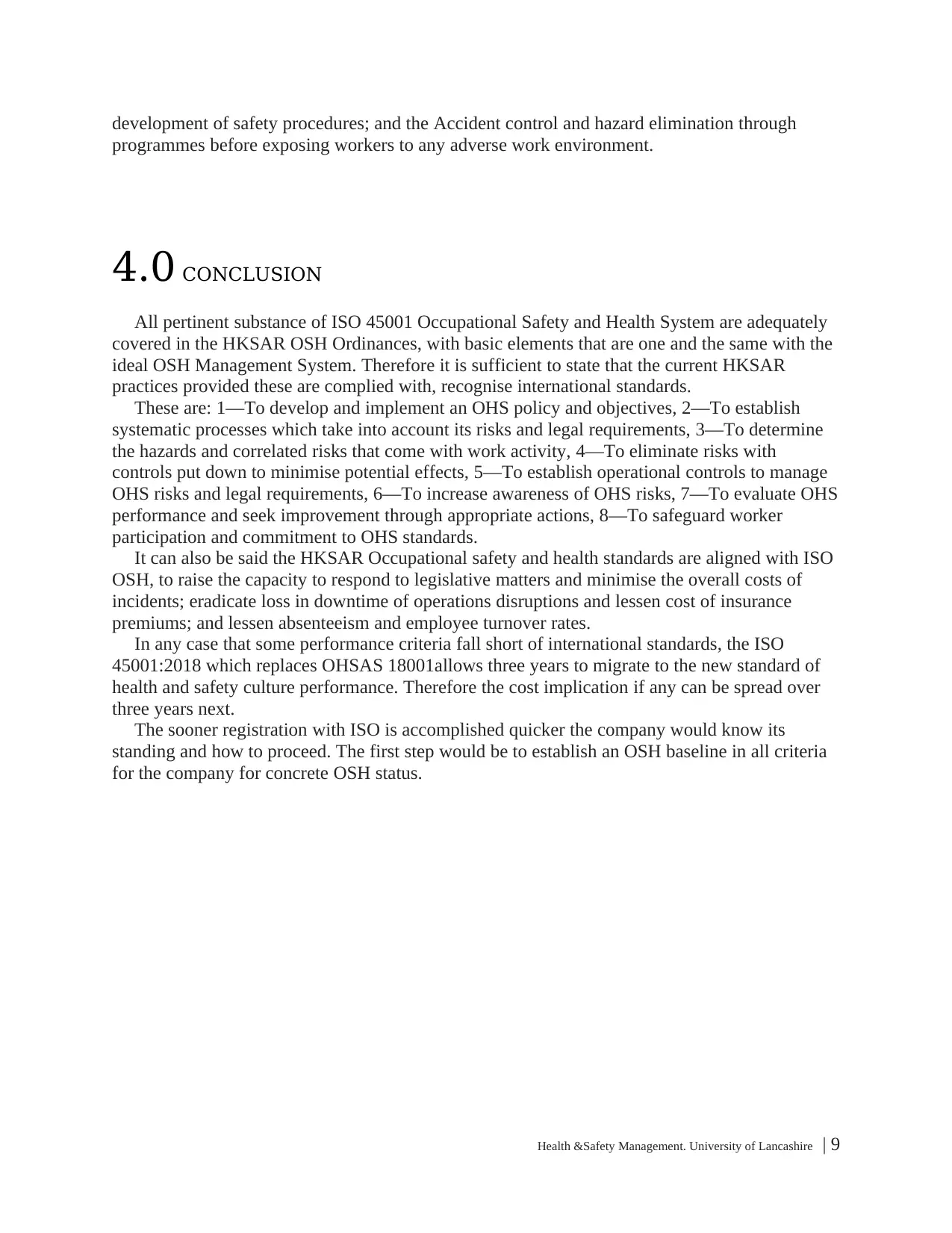
development of safety procedures; and the Accident control and hazard elimination through
programmes before exposing workers to any adverse work environment.
4.0 CONCLUSION
All pertinent substance of ISO 45001 Occupational Safety and Health System are adequately
covered in the HKSAR OSH Ordinances, with basic elements that are one and the same with the
ideal OSH Management System. Therefore it is sufficient to state that the current HKSAR
practices provided these are complied with, recognise international standards.
These are: 1—To develop and implement an OHS policy and objectives, 2—To establish
systematic processes which take into account its risks and legal requirements, 3—To determine
the hazards and correlated risks that come with work activity, 4—To eliminate risks with
controls put down to minimise potential effects, 5—To establish operational controls to manage
OHS risks and legal requirements, 6—To increase awareness of OHS risks, 7—To evaluate OHS
performance and seek improvement through appropriate actions, 8—To safeguard worker
participation and commitment to OHS standards.
It can also be said the HKSAR Occupational safety and health standards are aligned with ISO
OSH, to raise the capacity to respond to legislative matters and minimise the overall costs of
incidents; eradicate loss in downtime of operations disruptions and lessen cost of insurance
premiums; and lessen absenteeism and employee turnover rates.
In any case that some performance criteria fall short of international standards, the ISO
45001:2018 which replaces OHSAS 18001allows three years to migrate to the new standard of
health and safety culture performance. Therefore the cost implication if any can be spread over
three years next.
The sooner registration with ISO is accomplished quicker the company would know its
standing and how to proceed. The first step would be to establish an OSH baseline in all criteria
for the company for concrete OSH status.
Health &Safety Management. University of Lancashire | 9
programmes before exposing workers to any adverse work environment.
4.0 CONCLUSION
All pertinent substance of ISO 45001 Occupational Safety and Health System are adequately
covered in the HKSAR OSH Ordinances, with basic elements that are one and the same with the
ideal OSH Management System. Therefore it is sufficient to state that the current HKSAR
practices provided these are complied with, recognise international standards.
These are: 1—To develop and implement an OHS policy and objectives, 2—To establish
systematic processes which take into account its risks and legal requirements, 3—To determine
the hazards and correlated risks that come with work activity, 4—To eliminate risks with
controls put down to minimise potential effects, 5—To establish operational controls to manage
OHS risks and legal requirements, 6—To increase awareness of OHS risks, 7—To evaluate OHS
performance and seek improvement through appropriate actions, 8—To safeguard worker
participation and commitment to OHS standards.
It can also be said the HKSAR Occupational safety and health standards are aligned with ISO
OSH, to raise the capacity to respond to legislative matters and minimise the overall costs of
incidents; eradicate loss in downtime of operations disruptions and lessen cost of insurance
premiums; and lessen absenteeism and employee turnover rates.
In any case that some performance criteria fall short of international standards, the ISO
45001:2018 which replaces OHSAS 18001allows three years to migrate to the new standard of
health and safety culture performance. Therefore the cost implication if any can be spread over
three years next.
The sooner registration with ISO is accomplished quicker the company would know its
standing and how to proceed. The first step would be to establish an OSH baseline in all criteria
for the company for concrete OSH status.
Health &Safety Management. University of Lancashire | 9
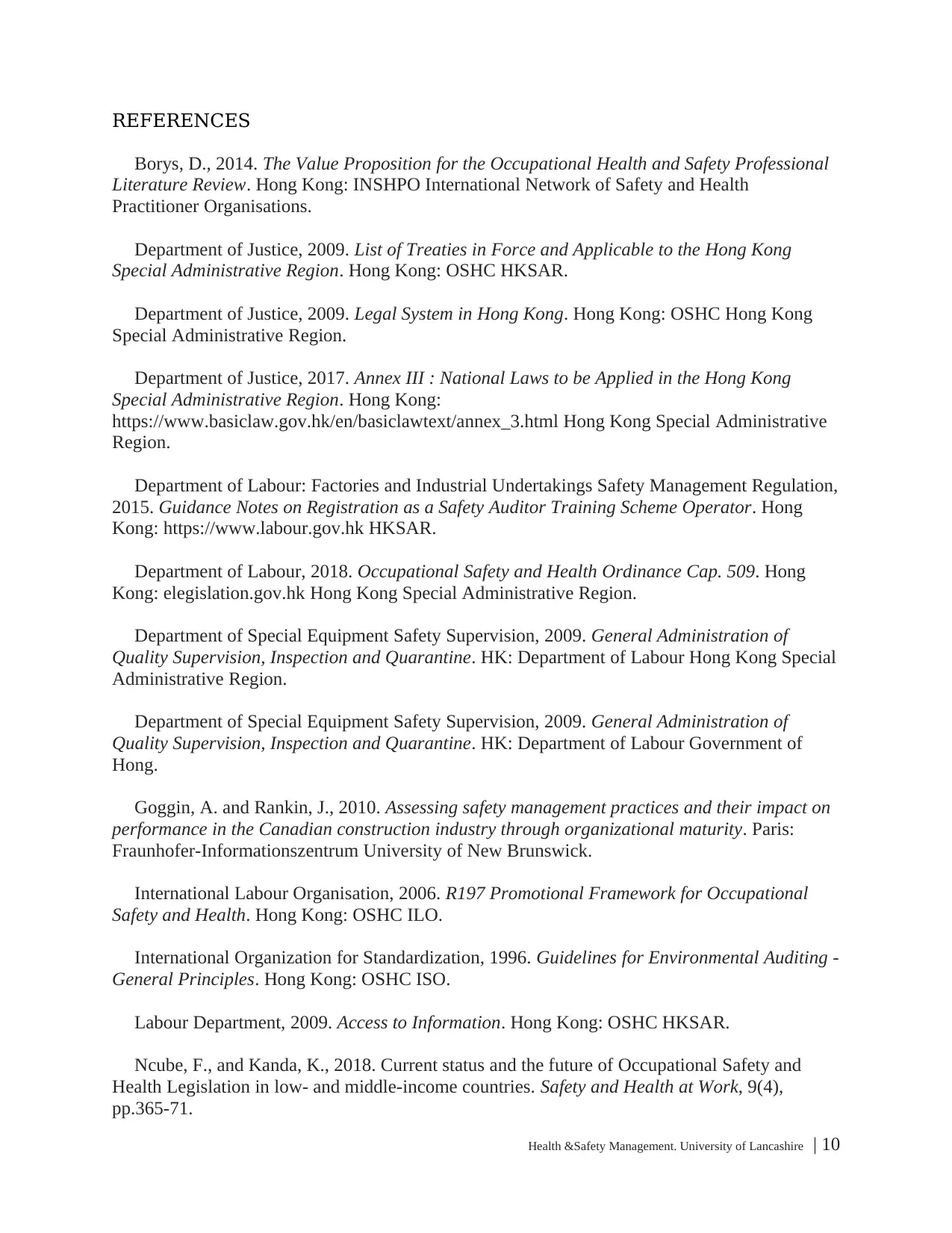
REFERENCES
Borys, D., 2014. The Value Proposition for the Occupational Health and Safety Professional
Literature Review. Hong Kong: INSHPO International Network of Safety and Health
Practitioner Organisations.
Department of Justice, 2009. List of Treaties in Force and Applicable to the Hong Kong
Special Administrative Region. Hong Kong: OSHC HKSAR.
Department of Justice, 2009. Legal System in Hong Kong. Hong Kong: OSHC Hong Kong
Special Administrative Region.
Department of Justice, 2017. Annex III : National Laws to be Applied in the Hong Kong
Special Administrative Region. Hong Kong:
https://www.basiclaw.gov.hk/en/basiclawtext/annex_3.html Hong Kong Special Administrative
Region.
Department of Labour: Factories and Industrial Undertakings Safety Management Regulation,
2015. Guidance Notes on Registration as a Safety Auditor Training Scheme Operator. Hong
Kong: https://www.labour.gov.hk HKSAR.
Department of Labour, 2018. Occupational Safety and Health Ordinance Cap. 509. Hong
Kong: elegislation.gov.hk Hong Kong Special Administrative Region.
Department of Special Equipment Safety Supervision, 2009. General Administration of
Quality Supervision, Inspection and Quarantine. HK: Department of Labour Hong Kong Special
Administrative Region.
Department of Special Equipment Safety Supervision, 2009. General Administration of
Quality Supervision, Inspection and Quarantine. HK: Department of Labour Government of
Hong.
Goggin, A. and Rankin, J., 2010. Assessing safety management practices and their impact on
performance in the Canadian construction industry through organizational maturity. Paris:
Fraunhofer-Informationszentrum University of New Brunswick.
International Labour Organisation, 2006. R197 Promotional Framework for Occupational
Safety and Health. Hong Kong: OSHC ILO.
International Organization for Standardization, 1996. Guidelines for Environmental Auditing -
General Principles. Hong Kong: OSHC ISO.
Labour Department, 2009. Access to Information. Hong Kong: OSHC HKSAR.
Ncube, F., and Kanda, K., 2018. Current status and the future of Occupational Safety and
Health Legislation in low- and middle-income countries. Safety and Health at Work, 9(4),
pp.365-71.
Health &Safety Management. University of Lancashire | 10
Borys, D., 2014. The Value Proposition for the Occupational Health and Safety Professional
Literature Review. Hong Kong: INSHPO International Network of Safety and Health
Practitioner Organisations.
Department of Justice, 2009. List of Treaties in Force and Applicable to the Hong Kong
Special Administrative Region. Hong Kong: OSHC HKSAR.
Department of Justice, 2009. Legal System in Hong Kong. Hong Kong: OSHC Hong Kong
Special Administrative Region.
Department of Justice, 2017. Annex III : National Laws to be Applied in the Hong Kong
Special Administrative Region. Hong Kong:
https://www.basiclaw.gov.hk/en/basiclawtext/annex_3.html Hong Kong Special Administrative
Region.
Department of Labour: Factories and Industrial Undertakings Safety Management Regulation,
2015. Guidance Notes on Registration as a Safety Auditor Training Scheme Operator. Hong
Kong: https://www.labour.gov.hk HKSAR.
Department of Labour, 2018. Occupational Safety and Health Ordinance Cap. 509. Hong
Kong: elegislation.gov.hk Hong Kong Special Administrative Region.
Department of Special Equipment Safety Supervision, 2009. General Administration of
Quality Supervision, Inspection and Quarantine. HK: Department of Labour Hong Kong Special
Administrative Region.
Department of Special Equipment Safety Supervision, 2009. General Administration of
Quality Supervision, Inspection and Quarantine. HK: Department of Labour Government of
Hong.
Goggin, A. and Rankin, J., 2010. Assessing safety management practices and their impact on
performance in the Canadian construction industry through organizational maturity. Paris:
Fraunhofer-Informationszentrum University of New Brunswick.
International Labour Organisation, 2006. R197 Promotional Framework for Occupational
Safety and Health. Hong Kong: OSHC ILO.
International Organization for Standardization, 1996. Guidelines for Environmental Auditing -
General Principles. Hong Kong: OSHC ISO.
Labour Department, 2009. Access to Information. Hong Kong: OSHC HKSAR.
Ncube, F., and Kanda, K., 2018. Current status and the future of Occupational Safety and
Health Legislation in low- and middle-income countries. Safety and Health at Work, 9(4),
pp.365-71.
Health &Safety Management. University of Lancashire | 10
Secure Best Marks with AI Grader
Need help grading? Try our AI Grader for instant feedback on your assignments.
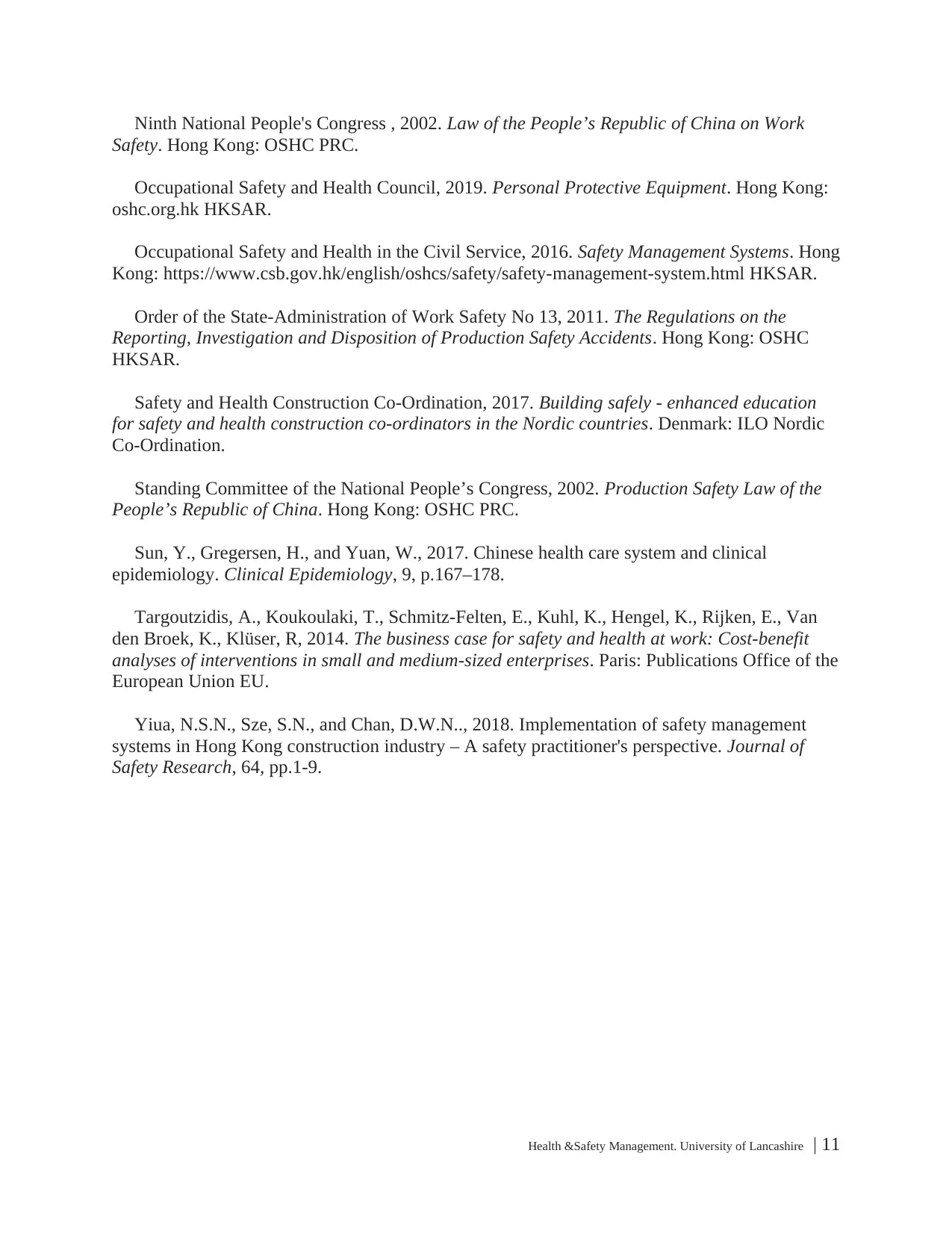
Ninth National People's Congress , 2002. Law of the People’s Republic of China on Work
Safety. Hong Kong: OSHC PRC.
Occupational Safety and Health Council, 2019. Personal Protective Equipment. Hong Kong:
oshc.org.hk HKSAR.
Occupational Safety and Health in the Civil Service, 2016. Safety Management Systems. Hong
Kong: https://www.csb.gov.hk/english/oshcs/safety/safety-management-system.html HKSAR.
Order of the State-Administration of Work Safety No 13, 2011. The Regulations on the
Reporting, Investigation and Disposition of Production Safety Accidents. Hong Kong: OSHC
HKSAR.
Safety and Health Construction Co-Ordination, 2017. Building safely - enhanced education
for safety and health construction co-ordinators in the Nordic countries. Denmark: ILO Nordic
Co-Ordination.
Standing Committee of the National People’s Congress, 2002. Production Safety Law of the
People’s Republic of China. Hong Kong: OSHC PRC.
Sun, Y., Gregersen, H., and Yuan, W., 2017. Chinese health care system and clinical
epidemiology. Clinical Epidemiology, 9, p.167–178.
Targoutzidis, A., Koukoulaki, T., Schmitz-Felten, E., Kuhl, K., Hengel, K., Rijken, E., Van
den Broek, K., Klüser, R, 2014. The business case for safety and health at work: Cost-benefit
analyses of interventions in small and medium-sized enterprises. Paris: Publications Office of the
European Union EU.
Yiua, N.S.N., Sze, S.N., and Chan, D.W.N.., 2018. Implementation of safety management
systems in Hong Kong construction industry – A safety practitioner's perspective. Journal of
Safety Research, 64, pp.1-9.
Health &Safety Management. University of Lancashire | 11
Safety. Hong Kong: OSHC PRC.
Occupational Safety and Health Council, 2019. Personal Protective Equipment. Hong Kong:
oshc.org.hk HKSAR.
Occupational Safety and Health in the Civil Service, 2016. Safety Management Systems. Hong
Kong: https://www.csb.gov.hk/english/oshcs/safety/safety-management-system.html HKSAR.
Order of the State-Administration of Work Safety No 13, 2011. The Regulations on the
Reporting, Investigation and Disposition of Production Safety Accidents. Hong Kong: OSHC
HKSAR.
Safety and Health Construction Co-Ordination, 2017. Building safely - enhanced education
for safety and health construction co-ordinators in the Nordic countries. Denmark: ILO Nordic
Co-Ordination.
Standing Committee of the National People’s Congress, 2002. Production Safety Law of the
People’s Republic of China. Hong Kong: OSHC PRC.
Sun, Y., Gregersen, H., and Yuan, W., 2017. Chinese health care system and clinical
epidemiology. Clinical Epidemiology, 9, p.167–178.
Targoutzidis, A., Koukoulaki, T., Schmitz-Felten, E., Kuhl, K., Hengel, K., Rijken, E., Van
den Broek, K., Klüser, R, 2014. The business case for safety and health at work: Cost-benefit
analyses of interventions in small and medium-sized enterprises. Paris: Publications Office of the
European Union EU.
Yiua, N.S.N., Sze, S.N., and Chan, D.W.N.., 2018. Implementation of safety management
systems in Hong Kong construction industry – A safety practitioner's perspective. Journal of
Safety Research, 64, pp.1-9.
Health &Safety Management. University of Lancashire | 11
1 out of 11
Your All-in-One AI-Powered Toolkit for Academic Success.
+13062052269
info@desklib.com
Available 24*7 on WhatsApp / Email
![[object Object]](/_next/static/media/star-bottom.7253800d.svg)
Unlock your academic potential
© 2024 | Zucol Services PVT LTD | All rights reserved.
